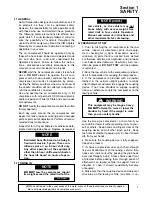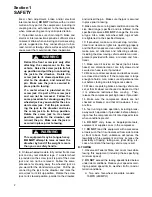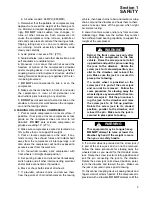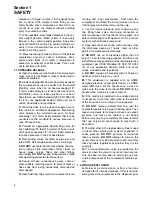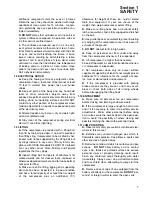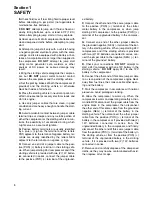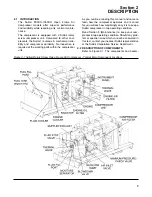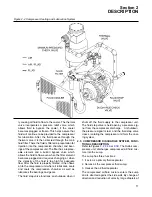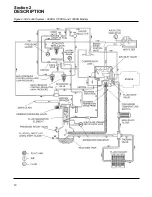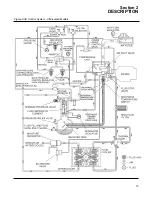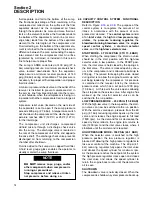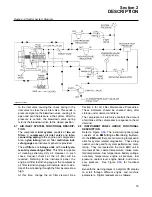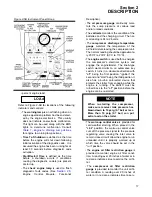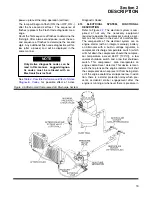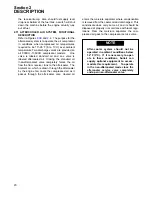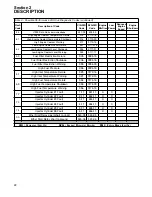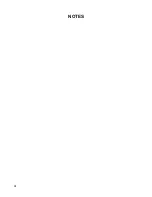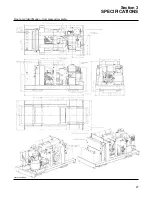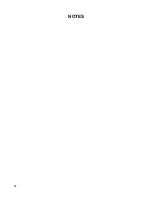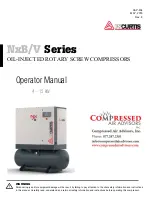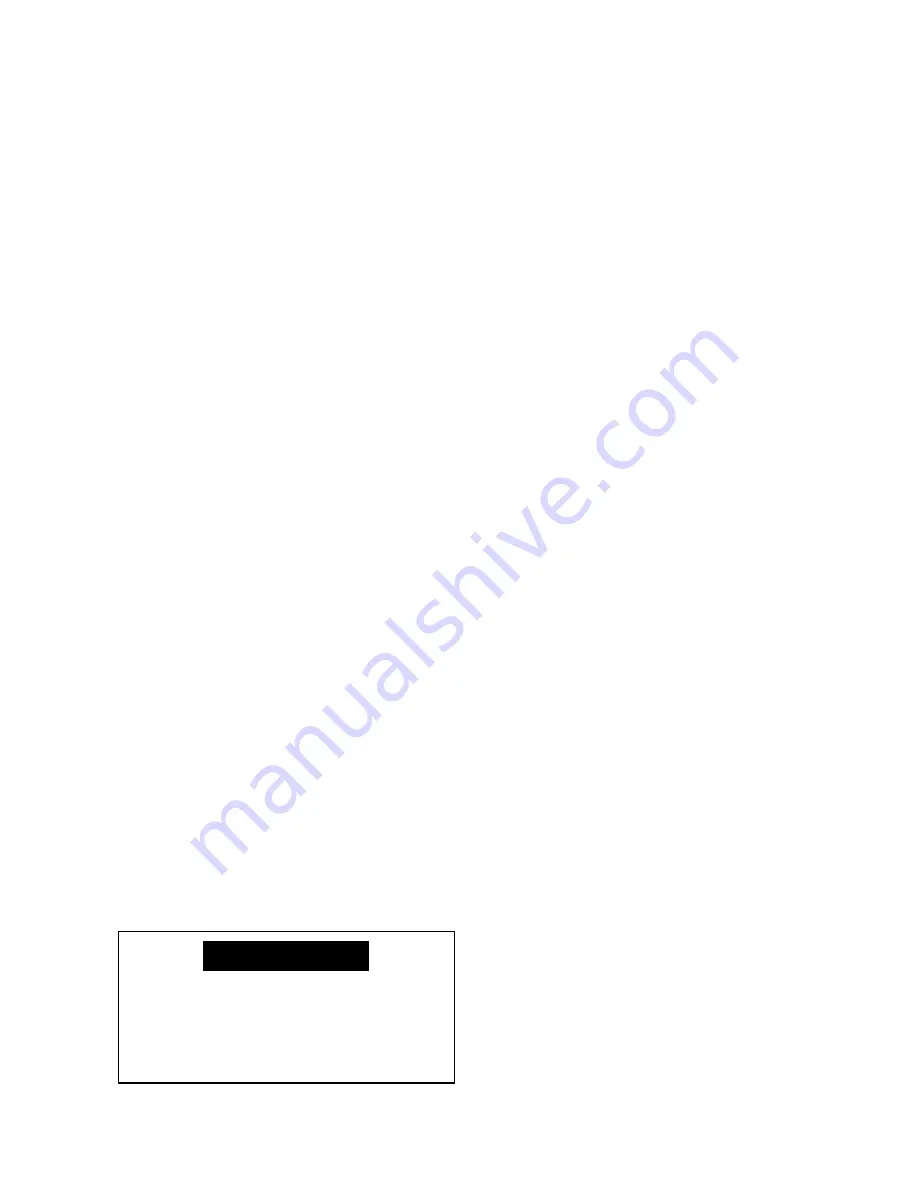
Section 2
DESCRIPTION
14
fluid separate and fall to the bottom of the sump.
The fractional percentage of fluid remaining in the
compressed air collects on the surface of the final
separator element as the compressed air flows
through the separator. As more and more fluid col-
lects on the element's surface, the fluid descends to
the bottom of the separator. A return line (or scav-
enge tube) leads from the bottom of the separator
element to the inlet region of the compressor unit.
Fluid collecting on the bottom of the separator ele-
ment is returned to the compressor by the pressure
difference between the area surrounding the sepa-
rator element and the compressor inlet. An orifice
(protected by a strainer) is included in this return
line to help assure proper flow.
The sump is ASME code rated at 400 psig (27.6
bar) working pressure. A minimum pressure/check
valve, located downstream from the separator,
helps assure a minimum receiver pressure of 140
psig (9.6 bar) during all conditions. This pressure is
necessary for proper air/fluid separation and proper
fluid circulation.
A minimum pressure/check valve at the outlet of the
receiver is installed to prevent compressed air in
the service line from bleeding back into the receiv-
er on shutdown when the compressor is being run
in parallel with other compressors tied to a large air
system.
A pressure relief valve (located on the wet side of
the separator) is set to open if the sump pressure
exceeds 400 psig ( 27.6 bar). A temperature switch
will shut down the compressor if the discharge tem-
perature reaches 265°F (129°C) or 250°F (121°C)
for the interstage.
The compressor unit discharges compressed
air/fluid mixture through a discharge check valve
into the sump. The discharge valve is located on
the rear of the compressor unit at the end opposite
the drive shaft. The discharge check valve prevents
discharged air from returning to the compression
chamber after shutdown.
Fluid is added to the sump via a capped fluid filler.
A fluid level gauge glass enables the operator to
visually monitor the sump fluid level.
2.6 CAPACITY CONTROL SYSTEM, FUNCTIONAL
DESCRIPTION
. The purpose of the
control system is to regulate the amount of air
intake in accordance with the amount of com-
pressed air demand. The
control system
consist
of an
inlet valve
, the
high
and
low pressure reg-
ulators
, the
pressure reducing regulator,
the
blowdown/running blowdown valve
, the
engine
speed control cylinder
, a
start-run selector
valve
, and the
high-low selector valve
.
START MODE - 0 TO 200 PSIG (0 TO 13.8 BAR)
When starting the compressor, the start-run valve
should be in the start position with the high-low
selector valve in low position. In the START posi-
tion, the inlet valve is held closed by the springs in
the inlet valve. The valve is cracked open by vacu-
um in the compressor and is allowed to build up to
200 psig. The reason for keeping the valve closed
during start is to allow the engine to warm up with-
out being loaded by the compressor. Air pressure
is contained in the receiver tank by the minimum
pressure valve which has a set point of 200 psig.
(13.8 bar), At this point the valve opens allowing
the air to pass to the service valve. After engine has
warmed up the run-start selector valve can be
switched to the run position.
LOW PRESSURE MODE - 200 PSIG (13.8 BAR)
With the high-low valve in the low position, the start-
run valve can now be switched to the run position.
With the service valve open, pressure from the 60
psig (4.1 bar) reducing regulator opens up the inlet
valve and increases the engine speed to full load
(1800 rpm). As the demand for air decreases the
speed cylinder retracts, the engine rpm returns to
idle (1400 rpm) and the inlet valve closes, where it
stabilizes until the air demand is required.
HIGH PRESSURE MODE - 350 PSIG (24.1 BAR)
When the selector valve is switched to the high
pressure position the low pressure regulator is
blocked off allowing the high pressure regulator to
take over control of the machine. The 60 psi (4.1
bar) reducing regulator fully opens the inlet valve
and strokes the speed cylinder for maximum rpm.
As the pressure reaches the set point of the system
the high pressure regulator cracks open and closes
the inlet valve and allows the speed cylinder to
return the engine back to idle, until the demand for
air is seen.
SHUTDOWN
The blowdown valve is normally closed. When the
compressor is shutdown, system pressure backs up
DO NOT
remove caps, plugs, and/or
other components when compressor is
running or pressurized.
Stop compressor and relieve all inter-
nal pressure before doing so.
NOTE
Summary of Contents for 1350XH
Page 6: ......
Page 18: ...Section 2 DESCRIPTION 12 Figure 2 3A Control System 900XH 1150XH and 1350XH Models...
Page 19: ...Section 2 DESCRIPTION 13 Figure 2 3B Control System Aftercooled Models...
Page 29: ...Section 2 DESCRIPTION 23 Figure 2 7 Wiring Diagram 02250145 161R01...
Page 30: ...NOTES 24...
Page 33: ...Section 3 SPECIFICATIONS 27 02250135 977R03 Figure 3 2 Identification Compressor Assembly...
Page 34: ...NOTES 28...
Page 38: ...NOTES 32...
Page 54: ...Section 7 ILLUSTRATIONS AND PARTS 48 02250127 622R08 7 3 ENGINE AND COMPRESSOR MOUNTING...
Page 56: ...Section 7 ILLUSTRATIONS AND PARTS 50 02250127 622R08 7 3 ENGINE AND COMPRESSOR MOUNTING...
Page 58: ...Section 7 ILLUSTRATIONS AND PARTS 52 02250136 060R02 7 4 AIR INLET SYSTEM ALL MODELS...
Page 60: ...Section 7 ILLUSTRATIONS AND PARTS 54 02250136 060R02 7 4 AIR INLET SYSTEM ALL MODELS...
Page 62: ...Section 7 ILLUSTRATIONS AND PARTS 56 02250136 062R02 7 5 EXHAUST SYSTEM ALL MODELS...
Page 72: ...Section 7 ILLUSTRATIONS AND PARTS 66 02250127 633R02 7 7 ENGINE RADIATOR ASSEMBLY ALL MODELS...
Page 74: ...Section 7 ILLUSTRATIONS AND PARTS 68 7 8 AFTERCOOLER MOUNTING ALL MODELS 02250150 135R03...
Page 82: ...Section 7 ILLUSTRATIONS AND PARTS 76 02250140 983R01 7 12A INLET VALVE AND PARTS 6 5 900XH...
Page 86: ...Section 7 ILLUSTRATIONS AND PARTS 80 02250054 762R06 7 13A INLET VALVE PARTS 6 5 900XH...
Page 90: ...Section 7 ILLUSTRATIONS AND PARTS 84 02250127 667R10 7 14A DISCHARGE SYSTEM 900XH AND 1150XH...
Page 96: ...Section 7 ILLUSTRATIONS AND PARTS 90 02250148 288R01 7 14C DISCHARGE SYSTEM 1350XH AFTERCOOLED...
Page 98: ...Section 7 ILLUSTRATIONS AND PARTS 92 02250148 288R01 7 14C DISCHARGE SYSTEM 1350XH AFTERCOOLED...
Page 116: ...Section 7 ILLUSTRATIONS AND PARTS 110 02250164 870R01 7 19 MINIMUM PRESSURE CHECK VALVE...
Page 118: ...Section 7 ILLUSTRATIONS AND PARTS 112 02250136 066R00 7 20 FUEL SYSTEM AND PARTS ALL MODELS...
Page 120: ...Section 7 ILLUSTRATIONS AND PARTS 114 02250127 727R01 7 21 ELECTRICAL PARTS ALL MODELS...
Page 126: ...Section 7 ILLUSTRATIONS AND PARTS 120 02250136 503R02 7 23 FRAME AND PARTS...
Page 128: ...Section 7 ILLUSTRATIONS AND PARTS 122 7 24 DECAL GROUP...
Page 130: ...Section 7 ILLUSTRATIONS AND PARTS 124 7 24 DECAL GROUP...
Page 132: ...Section 7 ILLUSTRATIONS AND PARTS 126 7 24 DECAL GROUP...
Page 134: ...Section 7 ILLUSTRATIONS AND PARTS 128 7 24 DECAL GROUP...
Page 136: ...Section 7 ILLUSTRATIONS AND PARTS 130 7 25 DECAL LOCATIONS 02250136 067R03...
Page 138: ...Section 7 ILLUSTRATIONS AND PARTS 132 7 25 DECAL LOCATIONS 02250136 067R03...
Page 140: ...NOTES 134...
Page 141: ......


